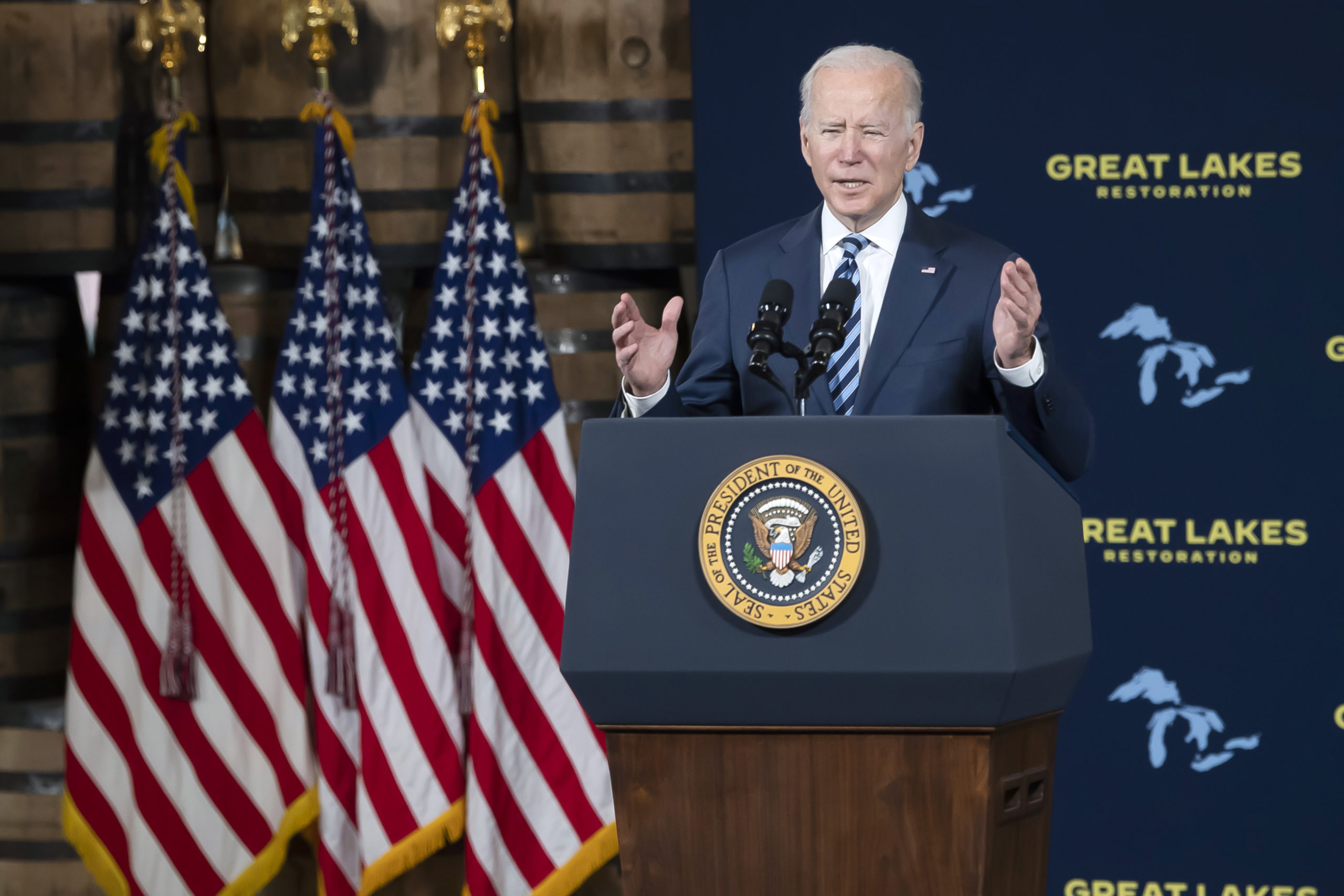
By John Flesher and Zeke Miller, Associated Press
LORAIN, Ohio (AP) — President Joe Biden declared Thursday that a $1 billion infusion from the bipartisan infrastructure deal would restore the Great Lakes harbors and tributary rivers that have been polluted by industrial toxins.
The president ventured close to the banks of Lake Erie to speak in Lorain, Ohio, a small city that once housed a shipbuilder, a Ford plant and a U.S. Steel factory and is now adapting to a post-industrial economy. Biden pledged that the investment in cleaning the waterways was as much about jobs as the environment, citing a note that Democratic Rep. Marcy Kaptur — who attended Thursday’s event — handed to him after an address last year to a joint session of Congress.
“That letter was about the Great Lakes,” the president said. “(They) support more than 1.3 million jobs in manufacturing tourism, transportation, warehousing, farming and fishing.”
Biden’s trip to northeast Ohio comes at a crucial political moment as the state’s Republican Sen. Rob Portman, Biden’s partner on the infrastructure deal, is retiring. That has left open a Senate seat this year that Democrats hope to claim, despite the state’s swing toward the GOP.
The $1 billion for the Great Lakes from the bipartisan measure enacted in November, combined with annual funding through an ongoing recovery program, will enable agencies by 2030 to finish work on 22 sites designated a quarter-century ago as among the region’s most degraded, officials said Thursday.
The lakes provide drinking water for 40 million people and underpin the economy in eight Northeastern and Midwestern states and two Canadian provinces. They fueled a 20th century industrial boom that generated wealth and jobs but caused ecological devastation.
Notorious images from the region including flames on the surface of the Cuyahoga River, which flows into Lake Erie at Cleveland, helped inspire enactment of the Clean Water Act and other signature environmental laws.
The U.S. and Canada listed 43 sites — 31 of them in the U.S. — as toxic hot spots in 1987, largely because of contaminated sediments that make the waters unsuitable for fishing, swimming and other uses.
But while cleanup plans were crafted, they languished with little funding until the Obama administration kicked off the Great Lakes Restoration Initiative in 2010.
It’s been one of the few matters on which the region’s congressional Democrats and Republicans routinely agree. They thwarted President Donald Trump’s early efforts to gut the program, which GOP lawmakers from Michigan eventually persuaded him to support.
Because of progress under the initiative, which has received nearly $4 billion, the Environmental Protection Agency has dropped six areas of concern from the list and finished work at 11 others. They’ll also be removed after scientists determine they have recovered, depending on factors such as whether wildlife populations are thriving.
The more than 6,000 projects funded under the restoration initiative also deal with some of the lakes’ other biggest problems. They include invasive species such as quagga mussels that unravel food chains; toxic algae blooms caused by agricultural runoff and sewage overflows; and loss of wetlands and other wildlife habitat.
The billion-dollar bonus from the infrastructure package will enable the EPA and other federal agencies to devote more resources to those issues from the program’s core budget. Congress voted separately in 2021 to increase the initiative’s annual funding from $300 million to $475 million over five years.
“The Great Lakes are North America’s most important source of freshwater, and President Biden is delivering on his promise to restore them for the millions of people and thousands of wildlife species they support,” said Collin O’Mara, president of the National Wildlife Federation.
Critics say the program has shortchanged low-income, minority communities and its focus on fixing past damage ignores the need for tougher rules to prevent future harm.
“Why restore a lake while another degrades?” Michael Isham, executive director of the Great Lakes Indian Fish and Wildlife Commission, said during a recent workshop sponsored by the nonprofit Institute for Journalism and Natural Resources.
The EPA said it will distribute the $1 billion from the infrastructure measure in keeping with a Biden pledge to deliver at least 40% of benefits from crucial federal investments to “underserved communities.”
Most of the infrastructure funds will be used for the hot spot cleanups, officials said during a news briefing ahead of Biden’s Ohio trip.
Of 25 U.S. sites still on the list, only three are expected to need further work by 2030, officials said. They include the St. Lawrence River in New York and Michigan’s Kalamazoo River, as well as the Saginaw River and Bay.
Among those where work should be done by then are Waukegan, Illinois; the Grand Calumet River in Indiana; the St. Louis River in Minnesota and Wisconsin; the Black and Cuyahoga rivers and Maumee, Ohio; the Niagara and Buffalo rivers, Eighteenmile and the Rochester Ebayment in New York; Wisconsin’s Fox River, Milwaukee Estuary and Sheboygan; and Michigan’s Muskegon Lake, River Raisin and Torch Lake along with the Clinton, Detroit, Manistique, Rouge, St. Clair and St. Marys rivers.
Catch more news at Great Lakes Now:
Michigan coastal management projects, programs get $1.1M
Featured image: President Joe Biden speaks the about the long-delayed cleanup of Great Lakes harbors and tributaries polluted with industrial toxins at the Shipyards, Thursday, Feb. 17, 2022, in Lorain, Ohio. Cleanup will accelerate dramatically with a $1 billion boost from Biden’s infrastructure plan. (AP Photo/Ken Blaze)




